Before diving deep into travel monetization and what tools you can use, it’s vital to understand what exactly monetization is. Monetization is the process of making money from traffic on your website or blog.
To start generating revenue from your website or blog, it’s necessary to build a steady flow of organic traffic to your website. To do this, you need to:
- Optimize your travel website for search engines
- Establish your presence on social media and use those platforms to drive traffic to your website
- Build a solid subscriber list and use emails to rope in an audience for your website
Though it may seem easy, driving organic traffic to your website is pretty time-consuming and requires a lot of effort. But, once you’ve gone through the necessary and your website has experienced an influx of traffic, it’s time to monetize.
8 ways to monetize your travel website
There are several ways to earn money on travel traffic, depending on the quality, volume, sources, audience markup, etc.
Here’re some of the most popular monetization strategies:
- Selling your product or courses. You can use your website to sell your skills or consultations.
- Setting up a drop-shipping store. In this monetization model, a seller doesn’t handle the product directly. When a customer makes a purchase, the seller buys an item from a third-party and has it shipped directly to the customer. This allows you to start with minimal investments.
- Free subscription or membership content. In this monetization strategy, you provide users with valuable, top-notch content for a fee. This can include pictures, photos, articles, niche tips, etc.
- Sponsored posts or product reviews. You get paid for creating content about a product or service and publishing that content on your travel website.
- Contextual advertising. To make money with contextual ads, leverage platforms such as Google AdSense, PropellerAds, etc.
- Selling ad space on your website. The usual model for this approach is the CPM or Cost per Thousand Views, but you can also set up some fixed fee.
- Donations. You can earn some money on your website by asking your audience to make donations.
- Affiliate marketing. Lea defines affiliate marketing [9:23] as a type of marketing in which affiliates earn commissions by promoting other brands’ products on their own websites. Affiliates are then rewarded when the desired action happens, such as a sale, click, or lead (depending on the business model).
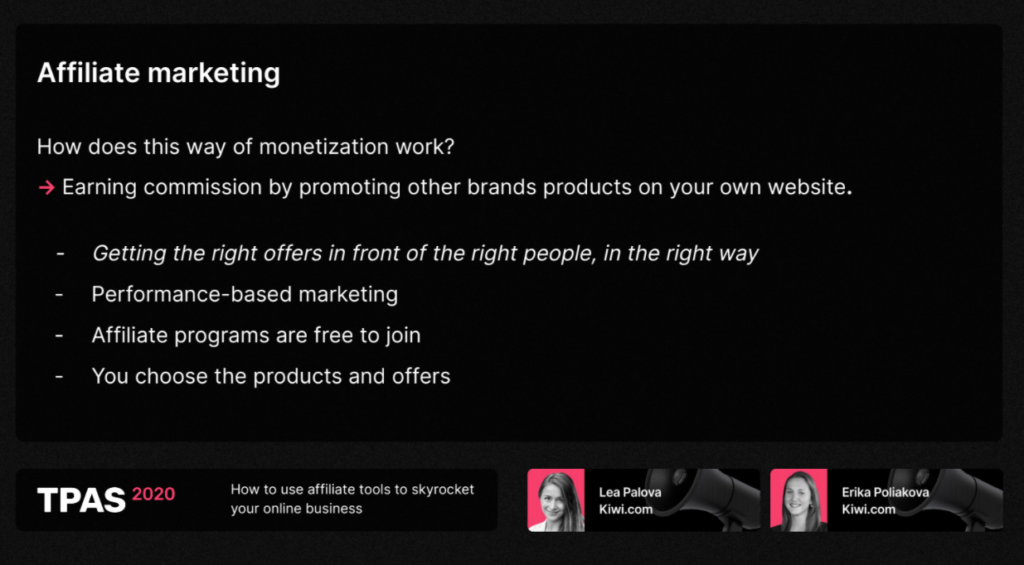
Affiliate programs are usually free to join and it’s up to you to choose your specific products and offers. So, you can pick what you really want to promote and what fits into your website’s niche.
There are five main steps to start earning with affiliate marketing:
- Join a travel affiliate program or network, such as Travelpayouts.
- Pick products or programs to promote.
- Choose the proper travel affiliate tools for promotion.
- Place these tools on your website or social media page.
- Earn affiliate commissions.
However, before you dig deeper into affiliate marketing, it’s vital to pick a niche that resonates with you. How can you choose one?
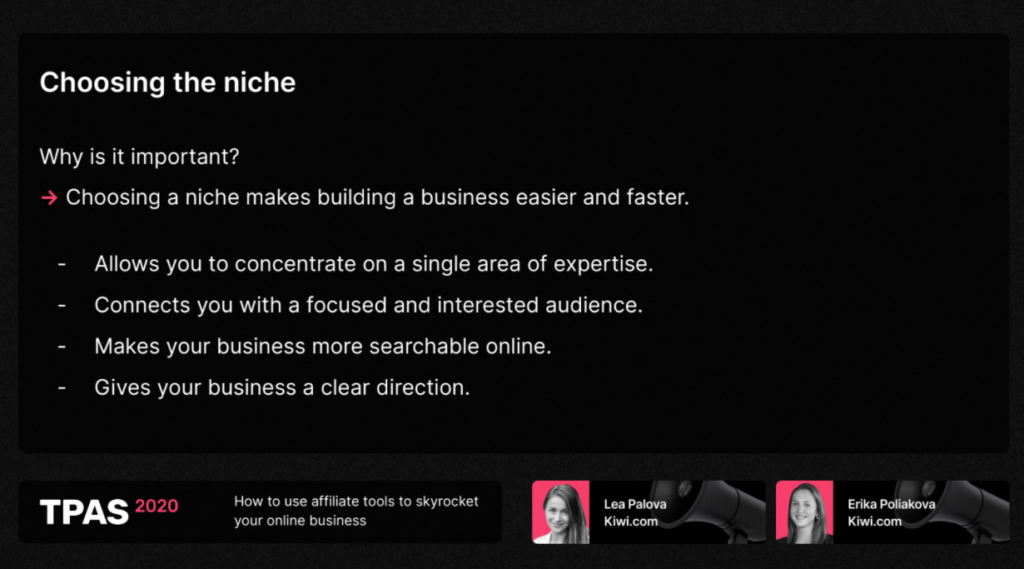
To choose a niche, select a topic you’re passionate about and build your marketing strategy around it. Always consider whether there’s any moneymaking potential in that specific niche.
If you’re a digital marketing novice, make sure you pick just one niche, as it will give your business a clear direction.
If you have some hands-on digital marketing experience, you can opt for more than one niche. This requires more effort to be invested and a larger start-up budget, but your travel affiliate earnings will also be higher.
Once you’ve picked the topics you’re interested in, do your research. You need to identify what’s trending in the niche by googling, communicating with people offline, conducting keyword and hashtag research, etc.
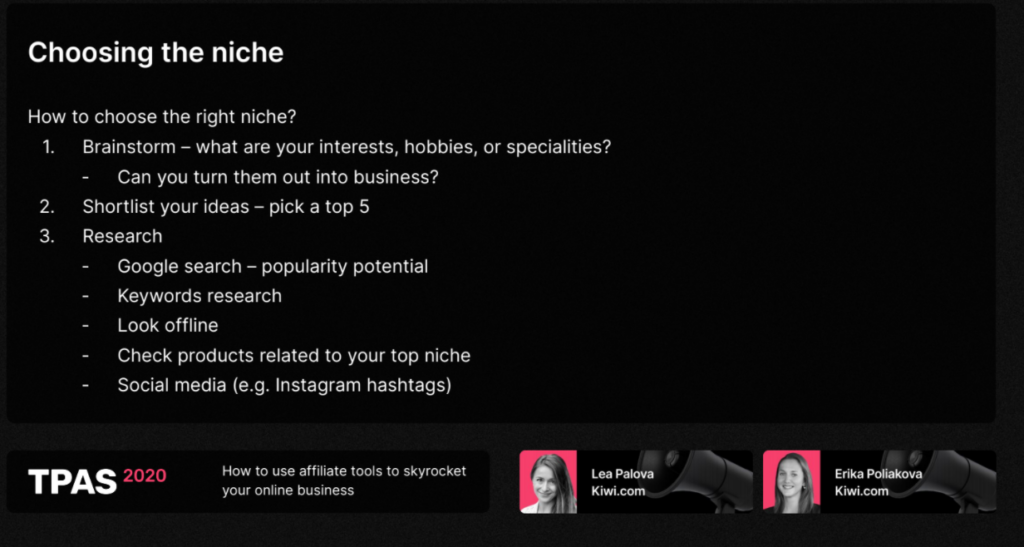
Last but not least, remember that “Passion WILL KILL the competition”. So, don’t forget what you are passionate about and try to find an appropriate niche for your hobbies.
Travel and Affiliate Marketing
Let’s take a closer look at the travel niche. Travel is a huge industry with tons of opportunities, plus there’s a wide range of travel affiliate programs.
So, here’re just a handful of trendy and profitable sub-niches within the travel field:
- Solo travel, business travel, family travel
- Budget travel/low-cost travel
- Air travel/hospitality
- Backpacking/adventure travel
- Destination weddings
- Wellness travel
- Gastro tourism
- Travel accessories
In the video [17:36], the speaker explains what makes the travel niche one of the biggest industries and provides some statistics from 2019 to illustrate just how massive travel is.
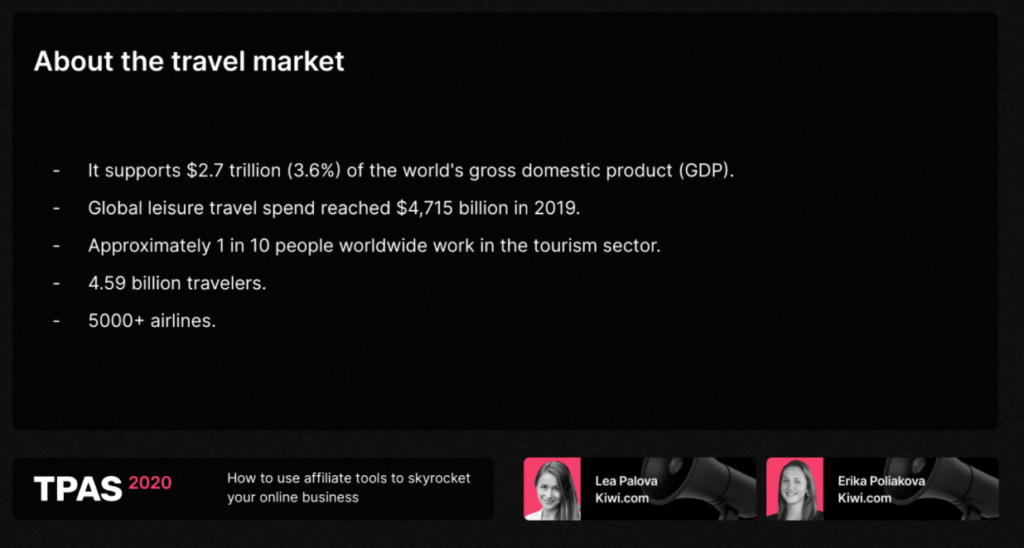
Like every niche, travel has its pros and cons.
| Pros | Cons |
| It’s a huge market with limitless moneymaking potential, especially in the transportation sector. | The niche is uber-competitive. |
| Its key players are well-known, respected brands. | The payouts, especially in the flight sector, are low compared to industries such as fashion, fitness, etc. |
| It offers global opportunities. | Customer lifetime value is low. This means that customers remain interested in your offers only for a short time. |
| It’s easy to advertise. | Link building is challenging because competition is so high. |
How to Take Advantage of kiwi.com Affiliate Tools
In the video [23:36], the speakers provide insights on how to make the most of the affiliate tools offered by Kiwi.com.
Kiwi.com is a pioneering platform that allows users to search for and book tickets without leaving the website. It also offers a unique Virtual Interlining feature that allows users to utilize connecting flights and other carriers that don’t typically work with one another.
The company’s mission is to make travel better and create seamless travel experiences for customers by helping them to get from any point A to any point B across the globe.
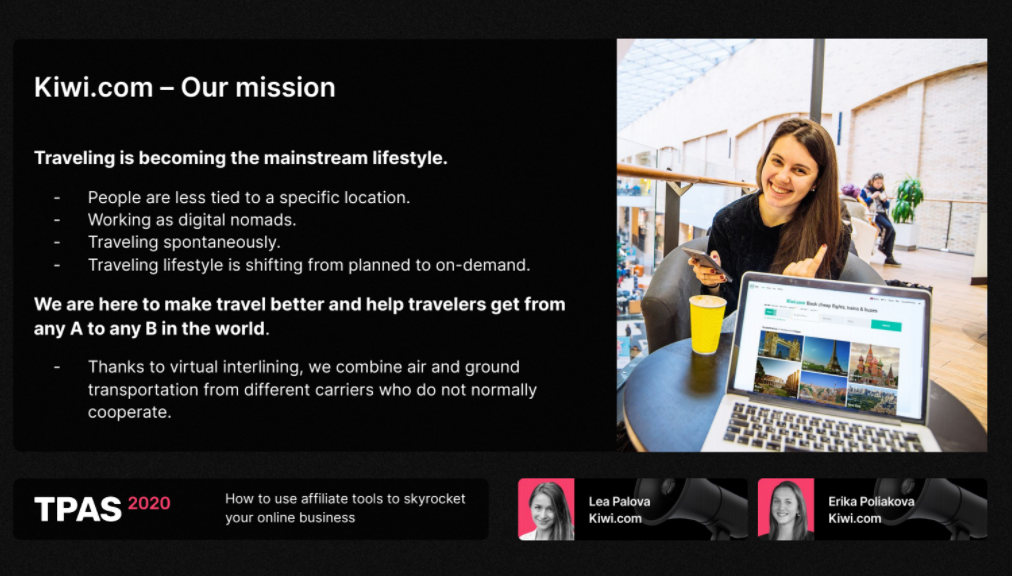
Kiwi provides a wide range of tools to help digital marketers monetize travel. The choice of tool depends on your type of business, website content, audience, and technical background.
Deeplinks
This is the most popular Kiwi tool that can be used for any partner type. Deeplinks are links on the Kiwi.com search page that include your affiliate ID and other parameters.
There are many ways to use deeplinks for monetization. For example, you can redirect to a specific webpage or embed deeplinks into content describing the Kiwi Nomad feature.
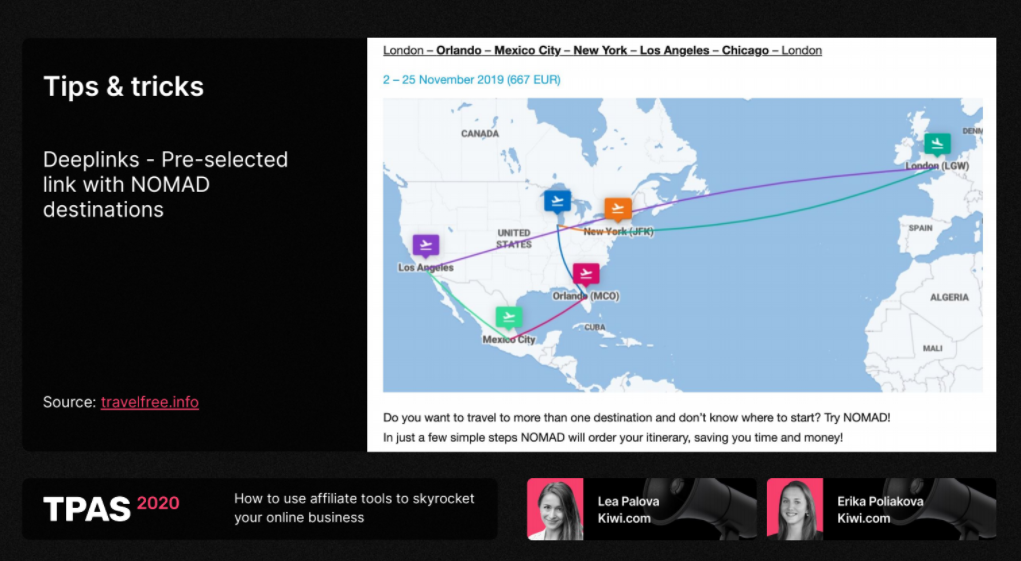
Widgets
Widgets are a perfect solution for sites with travel content. Kiwi offers an easy-to-use Widget Builder, which helps marketers create different types of widgets to serve different purposes in next to no time. You simply need to set the parameters in the Widget Builder and then copy the code into the place you want it displayed.
For example, you can create a Full widget that contains both a search and results section. Also, in the video [35:28], the speaker gives an example of the Tile widget used by airline websites. This type of widget doesn’t have the search part, but instead displays destinations as pictures based on a predefined origin.
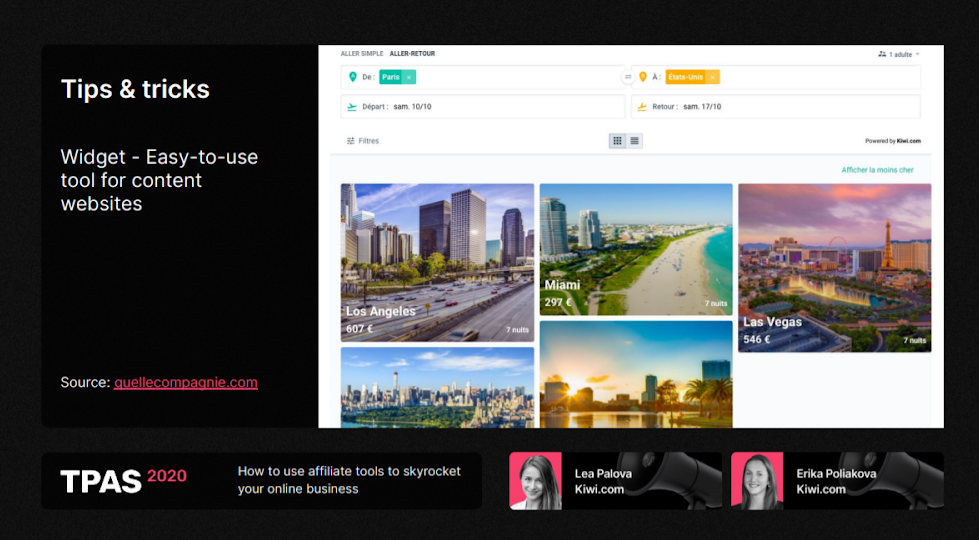
In addition, there’s the Result widget that displays a predefined flight route and the single O&D widget to promote a specific route.
Banners
Banners are usually tailored to the campaign or offer. Banners can be either placed on the side of your site or within an article. Once a user clicks on the banner, they will be redirected to Kiwi.com.
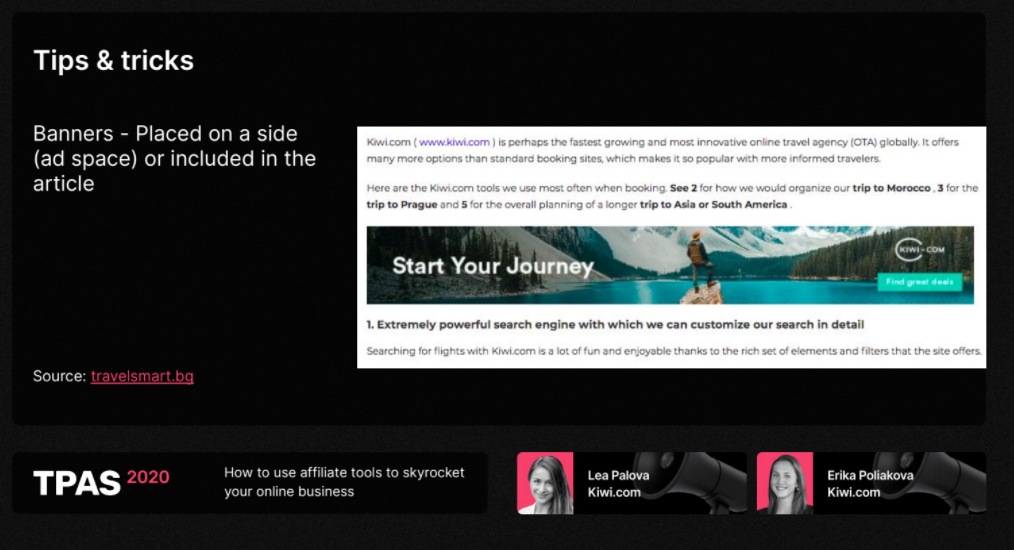
API
The Kiwi API is one of the most comprehensive transportation content databases in the world. This robust solution helps marketers collect real-time data. To implement the API, you will need to have some technical skills.
White Label
Kiwi offers a fully customized White Label solution for travel partners. It’s available for a range of use cases, including airlines, airports, and travel retailers.
Furthermore, there’re some extra tools available by agreement, including:
- Flexible CPA rates to support seasonal campaigns
- Promo codes, which are short discounts to back up seasonal campaigns. As a rule, promo codes prove very effective and convert well.
- The Nomad feature, which is an innovative travel search tool. This tool helps reduce your planning time and travel costs by shuffling the order of the cities to create a perfect itinerary.
- The best deals feed provides access to travel deals worldwide. You can download a CSV file with a list of deals that is updated every six hours.
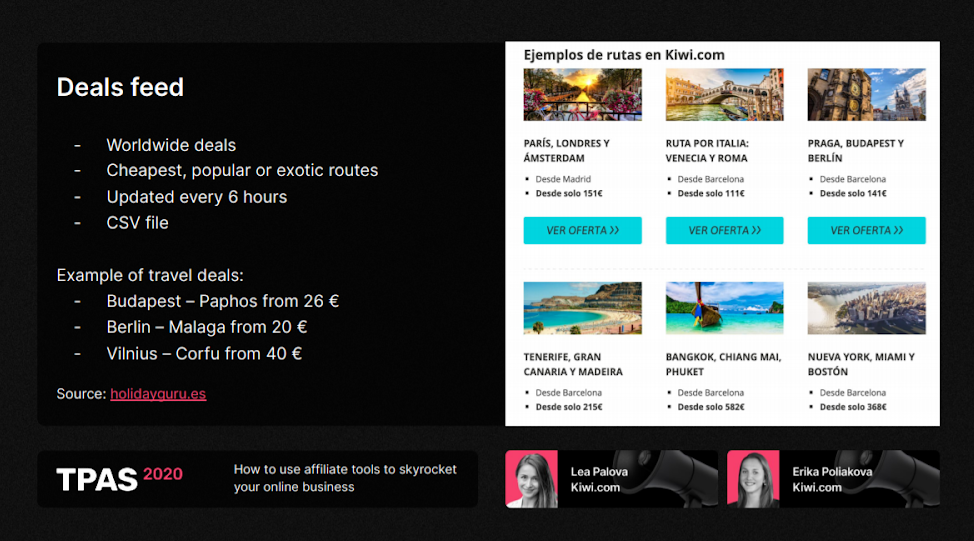
Erika Poliakova gives an example [30:25] of how to use the deals feed in combination with deeplinks.
Top 3 Dos and Don’Ts When Using Affiliate Tools
The speakers shared insider information about traps to avoid when using affiliate tools. They also unveiled some secrets to help you take your affiliate campaigns to the next level.
| Dos | Don’ts |
| Don’t use too many offers on your website as it will look spammy and can scare users away. | Run A/B tests to see what works best for your audience. Test tools design, placement, and offers. |
| Don’t promote tools to the wrong audience. For example, if you’re in the luxury travel niche, don’t try to sell your audience the Nomad feature, which has more appeal for budget travelers. | Publish offers and campaigns regularly. |
| Don’t give up too soon as building an affiliate business takes time. | Reach out to advertisers and ask them about offers and discounts. Even if they don’t have anything to offer right now, you can always plan something together. At least, you’ll get an update about future offers and deals. |
Bottom Line
There’s a huge earning potential in the travel niche and many travel affiliate programs to help you unlock it. To take off in affiliate marketing and create a profitable revenue stream, make the most of the affiliate tools offered by these programs. Be sure to promote these tools to the right audience, test what works best, and don’t lose heart too soon.
Presentation
You can download the presentation from the webinar at this link.



